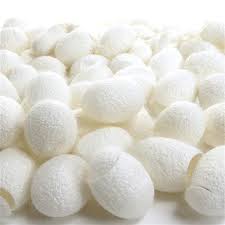DỊCH HOÀN THIỆN ĐỀ THI IELTS READING VÀ GIẢI THÍCH ĐÁP ÁN:
The Story of Silk
The history of the world’s most luxurious fabric, from ancient China to the present day
Lịch sử của loại vải sang trọng nhất trên thế giới, từ Trung Quốc cổ đại cho đến ngày nay.
Silk is a fine, smooth material produced from the cocoons - soft protective shells - that are made by mulberry silkworms (insect larvae). Legend has it that it was Lei Tzu, wife of the Yellow Emperor, ruler of China in about 3000 BC, who discovered silkworms. One account of the story goes that as she was taking a walk in her husband’s gardens, she discovered that silkworms were responsible for the destruction of several mulberry trees. She collected a number of cocoons and sat down to have a rest. It just so happened that while she was sipping some tea, one of the cocoons that she had collected landed in the hot tea and started to unravel into a fine thread. Lei Tzu found that she could wind this thread around her fingers. Subsequently, she persuaded her husband to allow her to rear silkworms on a grove of mulberry trees. She also devised a special reel to draw the fibres from the cocoon into a single thread so that they would be strong enough to be woven into fabric. While it is unknown just how much of this is true, it is certainly known that silk cultivation has existed in China for several millennia. ĐOẠN 1
Lụa tơ tằm là một chất liệu mịn và mượt được sản xuất từ kén tằm - những lớp vỏ bảo vệ mềm mại - được tạo ra từ tằm dâu ( ấu trùng công trùng). Tương truyền rằng chính Lôi Tử, vợ của Hoàng Đế, người trị vì Trung Quốc khoảng 3000 năm trước Công Nguyên, người đã khám phá ra con tằm. Một câu chuyện kể rằng khi bà ta đi dạo trong vườn của chồng, bà ta đã khám phá ra rằng những con tằm là nguyên nhân phá hủy những cây dâu tằm. Bà ấy đã nhặt nhiều kén tằm và ngồi xuống nghỉ ngơi. Tình cờ rằng trong lúc bà ta đang nhấp trà, một trong những kén tằm mà bà ấy đã nhặt được đáp xuống ly trà nóng và bắt đầu bung sợi thành một sợi chỉ mịn. Lôi Tử thấy rằng bà ta có thể cuốn sợi chỉ này quanh những ngón tay của bà. Sau đó, bà đã thuyết phục chồng bà cho phép bà nuôi tằm trên một lùm cây dâu. Bà ấy cũng nghĩ ra một trục quay đặc biệt để kéo sợi từ kén thành một sợi duy nhất sao cho chúng đủ chắc để dệt thành sợi vải. Mặc dù không biết câu chuyện này đúng đến mức nào nhưng người ta biết chắc rằng nghề làm lụa, trồng dâu nuôi tằm đã tồn tại ở Trung Quốc trong vài thiên niên kỷ.
Legend has it: tương truyền rằng
Originally, silkworm farming was solely restricted to women, and it was they who were responsible for the growing, harvesting and weaving. Silk quickly grew into a symbol of status, and originally, only royalty were entitled to have clothes made of silk. The rules were gradually relaxed over the years until finally during the Qing Dynasty (1644—1911 AD), even peasants, the lowest caste, were also entitled to wear silk. Sometime during the Han Dynasty (206 BC-220 AD), silk was so prized that it was also used as a unit of currency. Government officials were paid their salary in silk, and farmers paid their taxes in grain and silk. Silk was also used as diplomatic gifts by the emperor. Fishing lines, bowstrings, musical instruments and paper were all made using silk. The earliest indication of silk paper being used was discovered in the tomb of a noble who is estimated to have died around 168 AD. ĐOẠN 2
Ban đầu, việc nuôi tằm chỉ dành cho phụ nữ, và chính họ là người chịu trách nhiệm cho việc trồng trọt, thu hoạch và dệt vải. Lụa tơ tằm nhanh chóng phát triển thành một biểu tượng của địa vị và ban đầu, chỉ hoàng gia mới được đặc quyền mặc quần áo làm từ lụa. Các quy tắc dần dần được nới lỏng qua các năm cho đến cuối cùng vào thời nhà Thanh ( 1644-1911 sau Công Nguyên), thậm chí nông dân, tầng lớp thấp nhất cũng được phép mặc lụa. Có lúc trong triều đại nhà Hán ( 206 trước Công Nguyên - 220 sau Công Nguyên), lụa tơ tằm được đánh giá cao đến nổi nó được sử dụng như một đơn vị tiền tệ. Các quan chức chính phủ được trả lương bằng lụa, và những người nông dân trả thuế bằng ngũ cốc và lụa. Lụa cũng được sử dụng như những món quà ngoại giao của hoàng đế. Dây câu cá, dây cung, nhạc cụ và giấy đều được làm từ lụa. Dấu hiệu sử dụng giấy lụa sớm nhất được khám phá trong lăng mộ của một quý tộc được đoán là đã chết vào khoảng năm 168 sau Công nguyên.
Demand for this exotic fabric eventually created the lucrative trade route now known as the Silk Road, taking silk westward and bringing gold, silver and wool to the East. It was named the Silk Road after its most precious commodity, which was considered to be worth more than gold. The Silk Road stretched over 6,000 kilometres from Eastern China to the Mediterranean Sea, following the Great Wall of China, climbing the Pamir mountain range, crossing modern-day Afghanistan and going on to the Middle East, with a major trading market in Damascus. From there, the merchandise was shipped across the Mediterranean Sea. Few merchants travelled the entire route; goods were handled mostly by a series of middlemen. ĐOẠN 3

1. Mua bộ đề gần 400 bài ielts reading - Dịch và giải chi tiết Chỉ 199k bao gồm toàn bộ đề trong bộ Cambridge ( từ bộ 1 -19) và nhiều đề thi thực tế ( xem danh sách 400 đề ielts reading tại đây). Xem bài mẫu tại đây, Bài mẫu 1, bài mẫu 2, bài mẫu 3. Giải đề bao gồm phần dịch bài đọc, dịch phần câu hỏi, giải thích chi tiết, ( chỉ có thể tải, in phần đề để luyện tập, phần giải chi tiết và dịch chỉ xem online).
>>>>>>> Đặc biệt tặng kèm Dịch và giải chi tiết bộ đề Ielts listening từ Cam 10-18 và tặng kèm hơn 300 đề Ielts thực tế ( không có lời giải chi tiết chỉ có đề và đáp án) ( khác với bộ 400 đề ở trên). Vui lòng điền thông tin theo form tại đây và thanh toán theo thông tin CK trong form.
2. Đặc biệt dành tặng 100 bạn hoàn thành buổi học thử miễn phí khóa học Ielts Speaking online 1 kèm 1, các bạn sẽ được tặng bộ đề 400k bài Ielts reading và bộ đề Ielts Listening bộ Cam từ 10-18 gồm bài dịch và giải chi tiết, giải thích từ vựng khó ( thời hạn sử dụng trong vòng 2 tháng). Xem thông tin khóa học Ielts Speaking online 1 kèm 1 và đăng ký học thử tại đây.
With the mulberry silkworm being native to China, the country was the world’s sole producer of silk for many hundreds of years. The secret of silk-making eventually reached the rest of the world via the Byzantine Empire, which ruled over the Mediterranean region of southern Europe, North Africa and the Middle East during the period 330—1453 AD. According to another legend, monks working for the Byzantine emperor Justinian smuggled silkworm eggs to Constantinople (Istanbul in modern-day Turkey) in 550 AD, concealed inside hollow bamboo walking canes. The Byzantines were as secretive as the Chinese, however, and for many centuries the weaving and trading of silk fabric was a strict imperial monopoly. Then in the seventh century, the Arabs conquered Persia, capturing their magnificent silks in the process. ĐOẠN 4
Silk production thus spread through Africa, Sicily and Spain as the Arabs swept through these lands. Andalusia in southern Spain was Europe’s main silk-producing centre in the tenth century. By the thirteenth century, however, Italy had become Europe’s leader in silk production and export. Venetian merchants traded extensively in silk and encouraged silk growers to settle in Italy. Even now, silk processed in the province of Como in northern Italy enjoys an esteemed reputation. ĐOẠN 5
The nineteenth century and industrialisation saw the downfall of the European silk industry. Cheaper Japanese silk, trade in which was greatly facilitated by the opening of the Suez Canal, was one of the many factors driving the trend. Then in the twentieth century, new manmade fibres, such as nylon, started to be used in what had traditionally been silk products, such as stockings and parachutes. The two world wars, which interrupted the supply of raw material from Japan, also stifled the European silk industry. After the Second World War, Japan’s silk production was restored, with improved production and quality of raw silk. Japan was to remain the world’s biggest producer of raw silk, and practically the only major exporter of raw silk, until the 1970s. However, in more recent decades, China has gradually recaptured its position as the world’s biggest producer and exporter of raw silk and silk yarn. Today, around 125,000 metric tons of silk are produced in the world, and almost two-thirds of that production takes place in China. ĐOẠN 6
>>>>> Xem thêm:
♦ Tổng hợp câu trả lời, câu hỏi, từ vựng của hơn 70 chủ đề Ielts Speaking part 1
♦ Tổng hợp gần 400 đề thi Ielts reading ( bao gồm dịch, giải chi tiết, từ vựng)
Questions 1-9
Complete the notes below.
Choose ONE WORD ONLY from the passage for each answer.
Write your answers in boxes 1-9 on your answer sheet.
Early silk production in China
• Around 3000 BC, according to legend:
- silkworm cocoon fell into emperor’s wife’s 1 ....................
- emperor’s wife invented a 2 .................... to pull out silk fibres
• Only 3 .................... were allowed to produce silk
• Only 4 .................... were allowed to wear silk
• Silk used as a form of 5 ....................
- e.g. farmers’ taxes consisted partly of silk
• Silk used for many purposes
- e.g. evidence found of 6 .................... made from silk around 168 AD
Silk reaches rest of world
• Merchants use Silk Road to take silk westward and bring back 7 .................... and precious metals
• 550 AD: 8 .................... hide silkworm eggs in canes and take them to Constantinople
• Silk production spreads across Middle East and Europe
• 20th century: 9 .................... and other manmade fibres cause decline in silk
Questions 10-13
Do the following statements agree with the information in Reading Passage 194? In boxes 10-13 on your answer sheet, write
TRUE if the statement agrees with the information
FALSE if the statement contradicts the information
NOT GIVEN if there is no information on this
10. Gold was the most valuable material transported along the Silk Road.
11. Most tradesmen only went along certain sections of the Silk Road.
12.. The Byzantines spread the practice of silk production across the West.
13. Silk yarn makes up the majority of silk currently exported from China.
ĐÁP ÁN, GIẢI CHI TIẾT và DỊCH HOÀN THIỆN ĐỀ THI IELTS READING:
The Story of Silk
Questions 1-9
Complete the notes below.
Choose ONE WORD ONLY from the passage for each answer.
Write your answers in boxes 1-9 on your answer sheet.
Early silk production in China/ Sản xuất tơ lụa thở ban đầu ở Trung Quốc
• Around 3000 BC, according to legend:
Khoảng 3000 năm trước CN, theo như huyền thoại
- silkworm cocoon fell into emperor’s wife’s 1 ....tea................
kén tằm rơi vào trà của vợ hoàng đế
Giải thích: đoạn 1
She collected a number of cocoons and sat down to have a rest. It just so happened that while she was sipping some tea, one of the cocoons that she had collected landed in the hot tea and started to unravel into a fine thread
.............................................................................................................................................................................................
- emperor’s wife invented a 2 ......reel.............. to pull out silk fibres
vợ hoàng đế đã phát minh ra trục để kéo sợi tằm ra
Giải thích: đoạn 1
She also devised a special reel to draw the fibres from the cocoon into a single thread so that they would be strong enough to be woven into fabric.
.............................................................................................................................................................................................
• Only 3 .....woman............... were allowed to produce silk
Chỉ phụ nữ được phép sản xuất tơ lụa
• Only 4 .......royalty............. were allowed to wear silk
Chỉ hoàng tộc được phép mặc tơ lụa
• Silk used as a form of 5 ..currency..................
- e.g. farmers’ taxes consisted partly of silk
Tơ lụa được dùng như một hình thức tiền tệ
ví dụ: thuế của người nông dân bao gồm một phần tơ lụa
• Silk used for many purposes
Tơ lụa được dùng cho nhiều mục đích
- e.g. evidence found of 6 .....paper............... made from silk around 168 AD
Ví dụ bằng chứng được tìm thấy về giấy được làm từ tơ lụa khoảng 168 sau CN
Giải thích: đoạn 2
Originally, silkworm farming was solely restricted to women Q3, and it was they who were responsible for the growing, harvesting and weaving. Silk quickly grew into a symbol of status, and originally, only royalty were entitled to have clothes made of silk Q4. The rules were gradually relaxed over the years until finally during the Qing Dynasty (1644—1911 AD), even peasants, the lowest caste, were also entitled to wear silk. Sometime during the Han Dynasty (206 BC-220 AD), silk was so prized that it was also used as a unit of currency Q5. Government officials were paid their salary in silk, and farmers paid their taxes in grain and silk. Silk was also used as diplomatic gifts by the emperor. Fishing lines, bowstrings, musical instruments and paper were all made using silk. The earliest indication of silk paper Q6 being used was discovered in the tomb of a noble who is estimated to have died around 168 AD.
Silk reaches rest of world
Tơ lụa vươn ra phần còn lại của thế giới
• Merchants use Silk Road to take silk westward and bring back 7 ......wool.............. and precious metals
Các thương nhân dùng con đường tơ lụa để mang lụa đi về phía tây và mang về len và kim loại quý
Giải thích: đoạn 3
Demand for this exotic fabric eventually created the lucrative trade route now known as the Silk Road, taking silk westward and bringing gold, silver and wool to the East.
Answer:
1. tea
2. reel
3. women
4. royalty
5. currency
6. paper
7. wool
8. monks
9. nylon
10. FALSE
11. TRUE
12. FALSE
13. NOT GIVEN
1. Mua bộ đề gần 400 bài ielts reading - Dịch và giải chi tiết Chỉ 199k bao gồm toàn bộ đề trong bộ Cambridge ( từ bộ 1 -19) và nhiều đề thi thực tế ( xem danh sách 400 đề ielts reading tại đây). Xem bài mẫu tại đây, Bài mẫu 1, bài mẫu 2, bài mẫu 3. Giải đề bao gồm phần dịch bài đọc, dịch phần câu hỏi, giải thích chi tiết, ( chỉ có thể tải, in phần đề để luyện tập, phần giải chi tiết và dịch chỉ xem online).
>>>>>>> Đặc biệt tặng kèm Dịch và giải chi tiết bộ đề Ielts listening từ Cam 10-18 và tặng kèm hơn 300 đề Ielts thực tế ( không có lời giải chi tiết chỉ có đề và đáp án) ( khác với bộ 400 đề ở trên). Vui lòng điền thông tin theo form tại đây và thanh toán theo thông tin CK trong form.
2. Đặc biệt dành tặng 100 bạn hoàn thành buổi học thử miễn phí khóa học Ielts Speaking online 1 kèm 1, các bạn sẽ được tặng bộ đề 400k bài Ielts reading và bộ đề Ielts Listening bộ Cam từ 10-18 gồm bài dịch và giải chi tiết, giải thích từ vựng khó ( thời hạn sử dụng trong vòng 2 tháng). Xem thông tin khóa học Ielts Speaking online 1 kèm 1 và đăng ký học thử tại đây.

.png)

.jpg)




